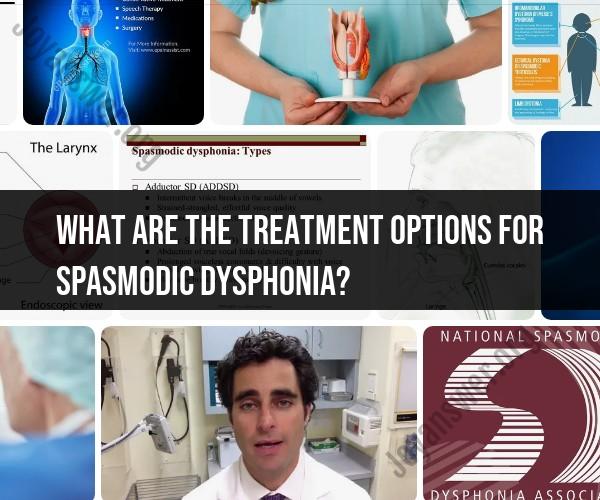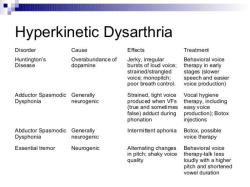What are the treatment options for spasmodic dysphonia?
Spasmodic dysphonia is a neurological disorder that affects the muscles of the larynx (voice box), causing spasms and involuntary interruptions in speech. While there is no cure for spasmodic dysphonia, several treatment options can help manage its symptoms and improve voice quality. Treatment approaches for spasmodic dysphonia may include:
Botulinum Toxin Injections (Botox):
- Botulinum toxin injections are the most common and effective treatment for spasmodic dysphonia. A trained healthcare professional, often a laryngologist or otolaryngologist, administers Botox injections into the affected laryngeal muscles.
- Botox temporarily weakens the overactive muscles, reducing voice spasms and improving speech clarity. The effects typically last for several months, after which further injections are needed.
Voice Therapy:
- Speech-language pathologists (SLPs) with expertise in voice disorders can provide voice therapy to individuals with spasmodic dysphonia. Voice therapy focuses on teaching strategies to manage symptoms and improve communication.
- Techniques may include relaxation exercises, breath control, and voice exercises that help individuals achieve better control over their speech.
Surgical Options:
- In some cases, surgery may be considered when other treatments are ineffective. Surgical options include:
- Selective denervation-reinnervation: This procedure involves cutting and re-routing nerves to the larynx to reduce spasms.
- Laryngeal nerve section: A surgical procedure to cut a portion of the recurrent laryngeal nerve to reduce spasms. This is a less common and more invasive option.
- In some cases, surgery may be considered when other treatments are ineffective. Surgical options include:
Alternative and Complementary Therapies:
- Some individuals with spasmodic dysphonia may explore alternative therapies like acupuncture, yoga, or relaxation techniques to manage stress and improve voice control. These approaches may be used in conjunction with traditional treatments but should be discussed with a healthcare provider.
Supportive Measures:
- Living with spasmodic dysphonia can be challenging, and individuals may benefit from support groups or counseling to address emotional and psychological aspects of the condition.
It's essential for individuals with spasmodic dysphonia to work closely with a healthcare team that includes a laryngologist, speech-language pathologist, and possibly a psychologist or counselor. Treatment plans should be individualized to address the specific needs and goals of each patient.
Additionally, some people with spasmodic dysphonia find it helpful to educate themselves about their condition, seek support from patient advocacy groups, and explore assistive communication devices or apps that can aid in communication during episodes of severe voice spasms.
Keep in mind that the effectiveness of treatments can vary among individuals, and it may take time to find the most suitable approach. Regular follow-up with healthcare providers is essential to monitor progress and adjust treatment plans as needed.
Treating Spasmodic Dysphonia: Exploring Treatment Options
Spasmodic dysphonia (SD) is a neurological voice disorder that causes involuntary muscle spasms in the larynx (voice box). This can lead to a variety of voice problems, such as breathiness, hoarseness, and difficulty speaking.
There is no cure for SD, but there are a number of treatments that can help to manage the symptoms and improve the quality of life for people with SD. Treatment options for SD include:
- Botulinum toxin injections: Botulinum toxin, also known as Botox, is a muscle relaxant that can be injected into the affected muscles of the larynx to help reduce muscle spasms. Botulinum toxin injections are typically effective for 3-4 months, and need to be repeated regularly to maintain the benefits.
- Speech therapy: Speech therapy can help people with SD to learn new ways of speaking that can reduce muscle strain and improve voice quality. Speech therapy can also help people with SD to develop coping strategies for managing their symptoms.
- Surgery: In some cases, surgery may be recommended to treat SD. Surgery involves cutting the nerve that controls the affected muscles of the larynx. This can be a very effective treatment, but it is also a major surgery with some risks.
Managing Dysphonia: Strategies for Coping with Spasmodic Dysphonia
In addition to the medical treatments listed above, there are a number of things that people with SD can do to manage their symptoms and improve their quality of life. These strategies include:
- Avoiding triggers: Certain triggers can worsen the symptoms of SD, such as stress, fatigue, and dehydration. People with SD should try to identify and avoid their triggers as much as possible.
- Speaking techniques: There are a number of speaking techniques that can help people with SD to reduce muscle strain and improve voice quality. These techniques include using a soft voice, avoiding whispering, and taking breaks when speaking.
- Vocal hygiene: Good vocal hygiene is important for everyone, but it is especially important for people with SD. Vocal hygiene practices include drinking plenty of fluids, getting enough sleep, and avoiding smoking.
- Support groups: Support groups can provide a valuable source of support and information for people with SD. There are a number of online and in-person support groups available.
Vocal Disorder Therapy: Available Treatment Choices for Spasmodic Dysphonia
Vocal disorder therapy is a broad term that encompasses a variety of treatment approaches that can be used to treat SD. The specific treatment approach that is recommended will depend on the individual's needs and preferences.
Some common types of vocal disorder therapy for SD include:
- Speech therapy: Speech therapy is a type of therapy that can help people with SD to learn new ways of speaking that can reduce muscle strain and improve voice quality. Speech therapy can also help people with SD to develop coping strategies for managing their symptoms.
- Voice therapy: Voice therapy is a type of therapy that focuses on improving the quality and efficiency of voice production. Voice therapy can be used to treat a variety of vocal disorders, including SD.
- Biofeedback: Biofeedback is a type of therapy that uses electronic devices to help people learn to control their bodily functions, such as muscle tension. Biofeedback can be used to help people with SD to reduce muscle spasms and improve voice quality.
If you are interested in learning more about the treatment options for SD, please talk to your doctor or a speech-language pathologist.












